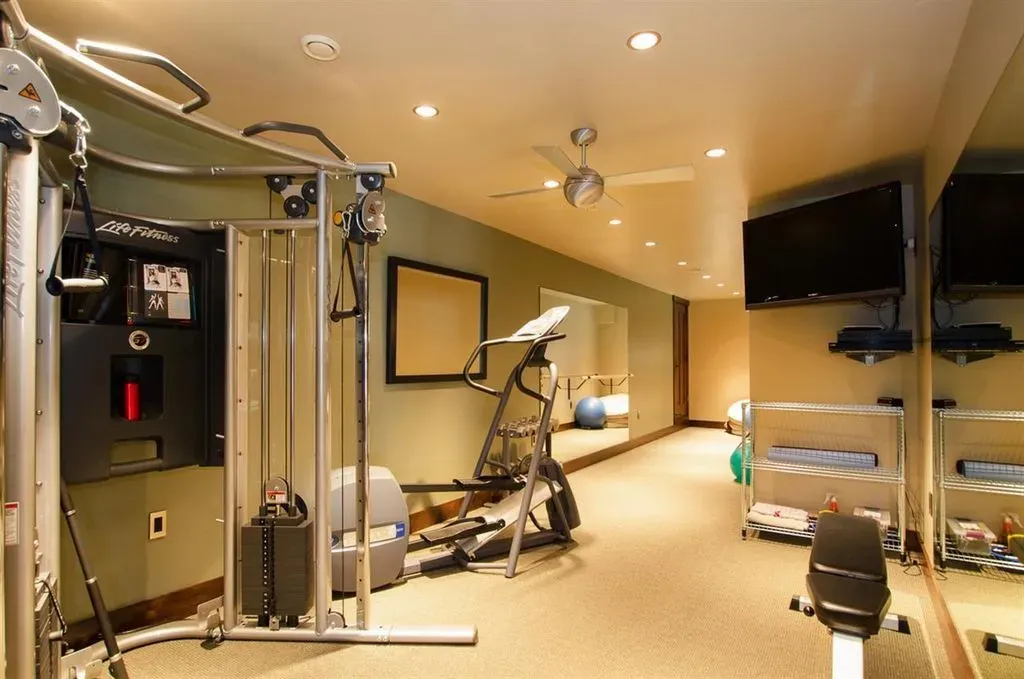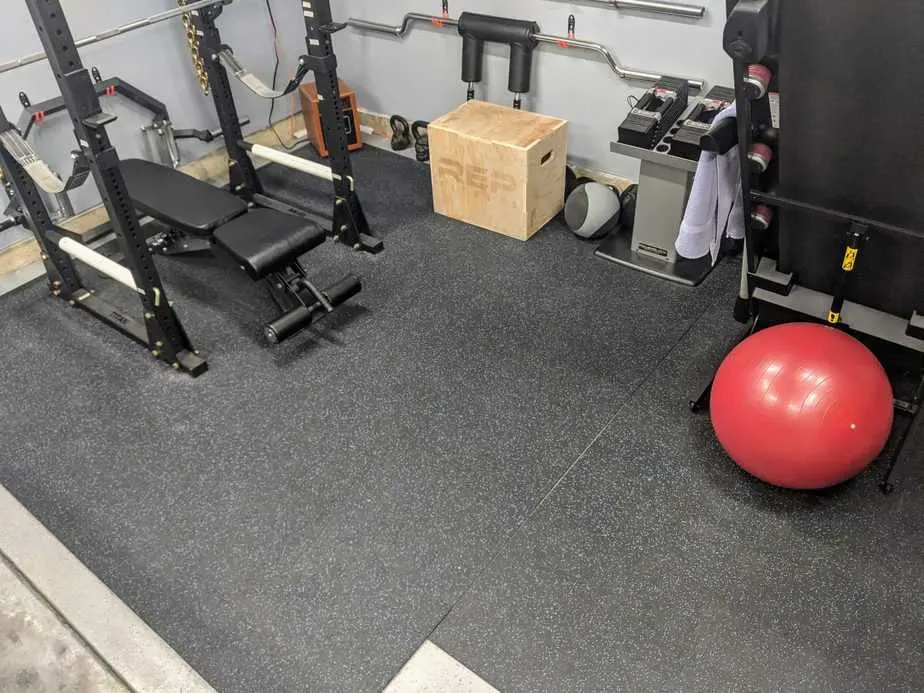Table of Contents
Dreaming of a home gym but staring up at an 8 foot ceiling with a sigh? You're not alone. Many basements and older homes come with ceiling heights that feel less than ideal for hoisting barbells or hanging from a pull-up bar. Standard power racks, often towering over 7 feet, seem like a non-starter. This common obstacle can make setting up a functional workout space feel impossible, leaving you wondering if floor exercises are your only option. But before you resign yourself to a life of push-ups and lunges, know this: a fully-equipped home gym is absolutely achievable, even with a modest 8 foot ceiling.
The Problem: Standard Racks vs. Your Home Gym 8 Foot Ceiling
The Problem: Standard Racks vs. Your Home Gym 8 Foot Ceiling
The Cold, Hard Math of Rack Height
So, you've got the space picked out for your home gym, maybe it's the basement or a spare room with that standard 8-foot ceiling. You start browsing for power racks, the cornerstone of many serious lifting setups. You see all these impressive rigs online, ready for squats, benches, pull-ups, you name it. Then you look at the specifications. Suddenly, reality hits like a dropped barbell. Most standard full-size power racks clock in at 7 feet tall, some even pushing 7.5 feet or more. Do the math: 8 feet is 96 inches. 7 feet is 84 inches. That leaves you with a mere 12 inches of clearance, maybe less depending on your floor mats or ceiling finish. This isn't just tight; it's often unusable for anything overhead.
When Your Head Meets the Ceiling (Literally)
That limited clearance isn't just an aesthetic issue. It directly impacts what you can actually *do* in your home gym 8 foot ceiling space. Think about pull-ups. The bar is usually mounted at the top of the rack. If the rack is 7 feet tall, the pull-up bar is effectively 7 feet off the ground. If you're taller than, say, 5'10" and try to hang fully extended, your head is likely going to smack the ceiling with every rep. Overhead presses or standing barbell curls become risky maneuvers requiring perfect, constrained form – or just plain impossible with a standard height bar. Safety is paramount, and a standard rack in an 8-foot space often compromises it.
- Standard racks often exceed 7 feet, leaving minimal clearance in 8-foot rooms.
- Common exercises like pull-ups and standing overhead presses are severely limited or unsafe.
- Risk of head contact with the ceiling during movements requiring vertical space.
- Reduced exercise variety due to height constraints.
Finding the Right Fit: Short Power Racks for Home Gym 8 Foot Ceiling Spaces
Finding the Right Fit: Short Power Racks for Home Gym 8 Foot Ceiling Spaces
so the standard 7-foot monsters are out. Does that mean your dreams of racking weights safely are dead? Absolutely not. This is where the heroes of the low-ceiling world come in: the short power racks. These aren't just chopped-down versions; they're specifically engineered to fit spaces like your home gym 8 foot ceiling. Typically, these bad boys stand around 6 feet tall, sometimes a hair under or over. That gives you a solid 2 feet of glorious clearance above the top of the rack – plenty of room to stand up after a squat, do some pressing from a bench, and critically, often includes a pull-up bar positioned low enough that you won't knock yourself out on the ceiling fan (assuming you don't have one directly over it, which, let's be real, is a whole other problem). Finding the right fit means looking for these shorter models designed with your vertical limitations in mind.
Beyond the Rack: Squat Stands and Alternatives for Low Ceilings
Beyond the Rack: Squat Stands and Alternatives for Low Ceilings
Considering Squat Stands for Vertical Freedom
Alright, maybe a full power rack, even a short one, feels like too much structure for your home gym 8 foot ceiling. Or perhaps you just want something simpler, more portable, or maybe you're on a tighter budget. Enter the squat stand. Think of these as the minimalist cousins of the power rack. They typically consist of two independent uprights or a connected frame with J-cups for holding the barbell. The beauty here? No top crossbar to bonk your head on during pull-ups (because there isn't one) or when reracking a heavy squat. Many squat stands are height-adjustable, and crucial for a low ceiling space, they don't impose a fixed maximum height the way a full cage does. You get the essential function of racking the weight for squats and bench press without sacrificing precious vertical clearance. It's a solid choice if overhead movements aren't your primary focus or if you're creative with where you do them.
Exploring Other Clever Workarounds
Beyond traditional racks and stands, the world of fitting a home gym into an 8 foot ceiling space gets creative. Wall-mounted folding racks are a fantastic option. They bolt directly into your wall studs, taking up zero floor space when folded away, and when extended, they offer uprights for squatting and benching. Again, no overhead bar to worry about hitting your head on during standing exercises, though pull-up bars on these can still be high, depending on the model. Another approach is utilizing safety spotter arms attached to wall-mounted uprights or even heavy-duty sawhorses (seriously, people do this safely with proper planning) for exercises like rack pulls or floor presses, where the movement range is inherently limited and doesn't require much vertical space. You can even use heavy-duty blocks or aerobic steps to elevate the bench for floor presses, effectively creating a "rack" for the lift-off.
- Squat stands offer racking capability without a restrictive overhead structure.
- Wall-mounted folding racks save floor space and provide uprights for squatting/benching.
- Consider safety spotter arms on wall mounts or sturdy supports for limited range-of-motion lifts.
- Creative solutions like blocks or steps can assist with lifts like floor presses.
Essential Exercises (and What to Avoid) in a Home Gym 8 Foot Ceiling Setup
Essential Exercises (and What to Avoid) in a Home Gym 8 Foot Ceiling Setup
Exercises That Play Nice with Low Ceilings
Look, an 8-foot ceiling isn't the end of your training world. Plenty of foundational, muscle-building movements work perfectly fine. Think about everything you do from the floor or a bench. Deadlifts? Zero ceiling issues there, unless you're planning on jumping at the top. Bench press? Rack it, unrack it, press it – all good, assuming your rack fits. Rows, whether bent-over with a barbell or dumbbell, or seated variations? No vertical constraints. Lunges, split squats, Romanian deadlifts? All safe bets. Even overhead pressing can work if you're seated on a bench. This setup forces you to get creative, perhaps favoring seated dumbbell presses over standing barbell presses, or focusing on floor presses instead of incline. The key is to identify movements where the peak height of the barbell or your head doesn't approach that 8-foot limit.
Movements That Become Problematic (or Dangerous)
Now for the bad news, or rather, the exercises you need to seriously rethink in a home gym 8 foot ceiling environment. Standing overhead barbell presses are the most obvious casualty. Unless you're under 5 feet tall or using dumbbells with perfect, compact form, you're risking head-to-ceiling contact. Similarly, pull-ups on a standard-height pull-up bar become a logistical nightmare. If the bar is 7 feet up and you're 5'10", that leaves you 2 inches of slack *before* you even start pulling. Clean and jerks or snatches, exercises that involve rapidly moving weight overhead, are generally off-limits due to the speed and height involved. Anything requiring explosive vertical extension with weight overhead needs careful consideration or outright avoidance. Ignoring these limitations isn't brave; it's a quick way to an injury or a hole in your drywall.
Exercises to Reconsider with an 8-Foot Ceiling:
- Standing Barbell Overhead Press
- Standard Pull-ups (on a high bar)
- Clean and Jerk
- Snatch
- Standing Dumbbell Overhead Press (if tall or using wide form)
Making the Most of Your Home Gym 8 Foot Ceiling Space
Making the Most of Your Home Gym 8 Foot Ceiling Space
Strategizing Your Layout and Equipment Choices
Working with a home gym 8 foot ceiling isn't about settling; it's about smart strategy. You've already dodged the bullet of buying a standard-height rack that won't fit. Now, think vertically and horizontally. Can you place taller equipment like a squat stand or short rack in the highest part of the room, perhaps avoiding a low-hanging beam or ductwork? Measure twice, buy once. Consider the footprint of equipment. A folding wall-mounted rack saves floor space when not in use, making the room feel bigger and more functional for other exercises. Even storage matters. Get weights off the floor and onto wall-mounted plate holders or a low rack. Every inch counts, both up and across. Don't just cram stuff in; curate your space like a minimalist architect.
Accessory selection is key too. Instead of a bulky lat pulldown attachment that might scrape the ceiling, consider resistance bands or a TRX suspension trainer anchored lower down. Adjustable benches are critical – look for ones that go flat for bench press but can incline for seated work without you hitting your head. Dumbbells are your best friend; they offer incredible versatility with minimal vertical requirement. Kettlebells are another winner. Think about the exercises you *can* do well in the space and prioritize equipment that supports those movements efficiently. It's about building a highly functional space, not just a room filled with shiny objects.
Smart Equipment & Layout Moves:
- Prioritize short power racks, squat stands, or wall-mounted options.
- Map out the highest points in your room and position equipment accordingly.
- Utilize vertical wall space for storage (plate holders, band hooks).
- Choose versatile accessories like resistance bands or adjustable dumbbells.
- Opt for an adjustable bench that works for flat and seated exercises.
Adapting Your Training to the Space
Your home gym 8 foot ceiling might dictate *how* you perform certain exercises, and that's not necessarily a bad thing. If standing overhead presses are out, seated variations with dumbbells or barbells are perfectly effective for shoulder development. Floor presses are a fantastic alternative to bench press, hitting your chest hard with a limited range of motion that keeps the bar away from the ceiling. Instead of traditional pull-ups on a high bar, look at ring rows or inverted rows using a lower bar or suspension trainer. These hit similar muscle groups and can be just as challenging. Don't view the height limit as a restriction, but as an opportunity to explore different exercise variations you might not have otherwise tried.
Think outside the box. Can you do deficit deadlifts by standing on a plate or block? Absolutely. Can you get a great leg workout with Bulgarian split squats or heavy dumbbell lunges? You bet. Plyometrics might need careful planning – maybe box jumps onto a lower box or broad jumps instead of vertical leaps. Bodyweight training, rings, and specialized bars (like a multi-grip bar that might keep your hands lower) become more attractive options. The goal is consistent, effective training. If you can't do a standard barbell overhead press, finding three other ways to train your shoulders effectively is a win, not a loss. Adaptability is the name of the game when maximizing a home gym 8 foot ceiling.
Your Home Gym 8 Foot Ceiling: Mission Accomplished
So there you have it. Building a functional home gym with an 8 foot ceiling isn't some mythical quest reserved for those blessed with cavernous basements. It boils down to understanding the constraints and making smart choices about your gear. You might not be able to hang upside down like a bat or perform standing overhead presses with a 7-foot bar, but that doesn't mean your gains are capped. Short racks, squat stands, and a willingness to adapt your exercise selection mean you can still build serious strength and fitness right under that lower ceiling. It requires a bit more planning than just grabbing the first standard rack you see, sure, but the payoff – consistent, convenient training in your own space – is well worth the minor hassle of measuring twice and buying once. Now go lift something.